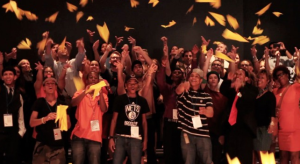The following is the beginning of a piece by Rachel Barnard posted July 17 in Urban Omnibus titled "Young New Yorkers: Restorative Justice Through Public Art."
 The Young New Yorkers write their dreams on a paper airplane and give them flight to conclude the programThe wide-angle lens captures the flickering of a fan overhead and the outstretched leg of a small child sitting just out of frame. It is summer in New York and Isaiah’s grandmother is sitting on a quilted day bed that has been pushed up against a wooden partition and partially obstructs the entrance to her kitchen. Her left leg is neatly curled under her right; her left arm props herself up on the bed’s surface. Her head, framed by long braids, leans intently forward. She speaks directly into the camera her grandson is holding:
The Young New Yorkers write their dreams on a paper airplane and give them flight to conclude the programThe wide-angle lens captures the flickering of a fan overhead and the outstretched leg of a small child sitting just out of frame. It is summer in New York and Isaiah’s grandmother is sitting on a quilted day bed that has been pushed up against a wooden partition and partially obstructs the entrance to her kitchen. Her left leg is neatly curled under her right; her left arm props herself up on the bed’s surface. Her head, framed by long braids, leans intently forward. She speaks directly into the camera her grandson is holding:
I was sad because it's not like you committed a crime like you robbed someone, or you beat up someone, or you killed someone. It broke my heart that for such a minor offense you had to face the crime. Because it is a crime. Whether you do graffiti, whether you jump the turnstile, they are all crimes.
Isaiah is interviewing his grandmother as part of a homework assignment for Young New Yorkers, a restorative justice arts program for 16- and 17-year-olds with open criminal cases. The assignment asks Isaiah, and his fellow participants, to interview people important to them about the personal impact of their misconduct. Isaiah’s grandmother’s response is typical of a guardian or mentor, a combination of belief and encouragement coupled with utter frustration:
There is no excuse for jumping a turnstile. Because, yeah we’re not rich people, but if you come over here and you need money to go home you know I will give it to you. And if your mother doesn’t have what you need to get to where you’re going: Just. Don’t. Go. It is not worth it! To be behind bars over jumping a turnstile!
…
Use your graffiti as an art. Go to school. Get formal training. Let someone hire you, commission you. Maybe one day you will be in a museum. Graffiti is an art. Use your talent the correct way to earn a living. Make it a career doing something that you love.
The Young New Yorkers program blends artistic expression with restorative justice in a powerful way. The main theme the program attempts to convey, according to Barnard, is that "You have something important to say; however, in order for others to listen, you first need to take responsibility for your past actions."
As an alternative to incarceration, the program allows youth offenders to remain in the community and through a series of workshops explore the impact their actions have had on others and themselves using a variety of artistic mediums, including photography, video, drawing and collage.
Read Young New Yorkers: Restorative Justice Through Public Art, which describes the program in full and includes a number of great photographs, including some of the art the youth produced. Watch an 8-minute video of The Young New Yorkers.
Reading this piece reminded of a similar project based in the Shetland Islands, a part of Scotland, UK, that I heard about at IIRP's last international conference. The "space2face" program, a joint project of Shetland Arts and the Community Mediation Team, pairs young offenders with professional artist mentors to create a piece of work that will be given to victims or a community in order to help heal in the wake of a crime. Visit the space2face web page and read an article about the ongoing project.
